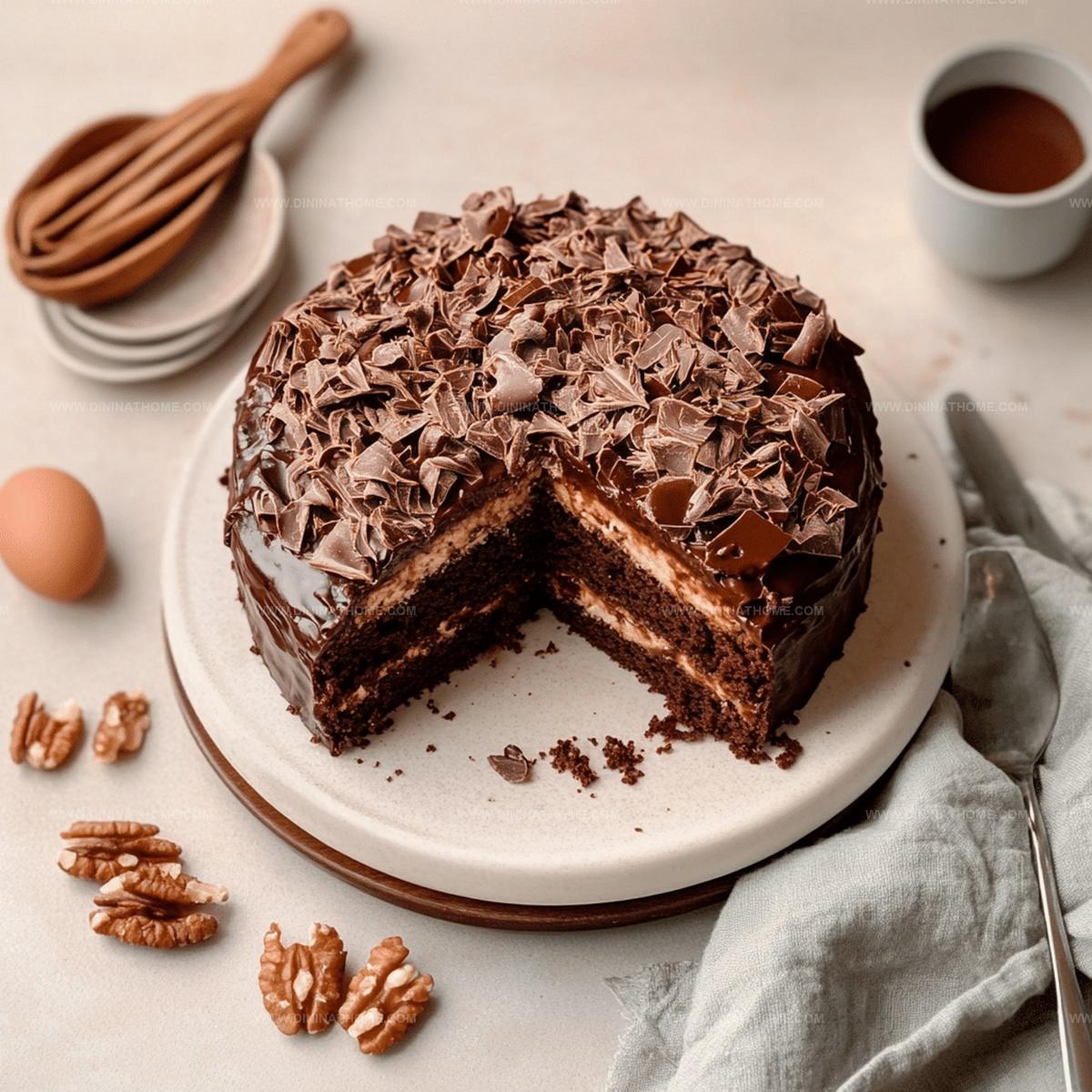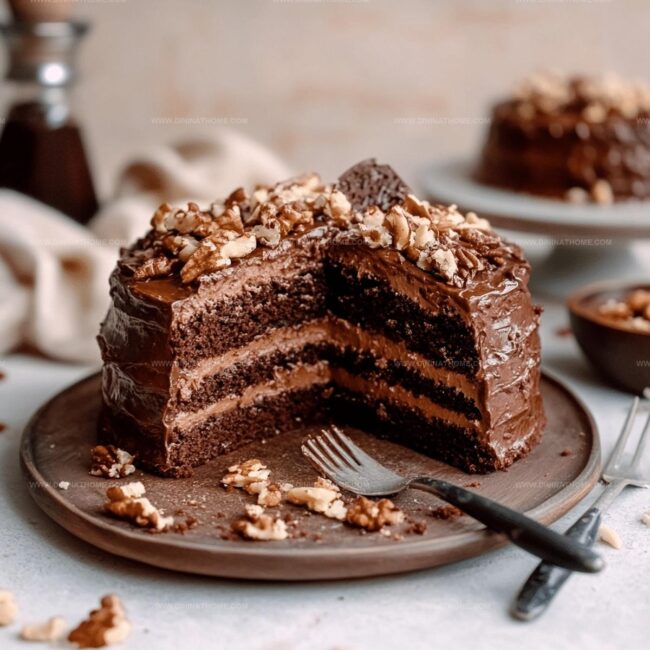Dreamy German Chocolate Cake Recipe: Sweet Coconut Paradise
Memories of grandma’s kitchen always flood back when I whip up this decadent german chocolate cake that melts hearts instantly.
Sweet layers of nostalgia dance between rich chocolate and coconut.
Soft crumbs tell stories of celebration and warmth.
Creamy frosting whispers secrets of culinary comfort passed down through generations.
Every slice carries the magic of traditional baking techniques blended with pure love.
Your taste buds will embark on a delightful journey of indulgence.
Bring this classic dessert to life and watch smiles bloom around your table.
German Chocolate Cake That’s Extra Decadent
Effortless Wow Factor: This German chocolate cake transforms ordinary baking into an extraordinary culinary experience with its rich, decadent layers that look professionally crafted.
Crowd-Pleasing Comfort: Perfect for family gatherings, birthdays, and special celebrations where guests will be impressed by the stunning combination of chocolate, coconut, and pecans.
Weekend Baking Delight: A rewarding project for home bakers wanting to elevate their skills, with step-by-step instructions that make creating a gourmet dessert feel surprisingly achievable.
Customizable Indulgence: Flexible recipe allows decorating creativity – choose between frosted sides or traditional bare layers, making each cake uniquely personal and visually stunning.
German Chocolate Cake Ingredient Breakdown
Cake Base Ingredients:Dry Ingredients:Liquid Ingredients:German Chocolate Cake Step Breakdown
Step 1: Preparing the Cake Base
Warm up your oven to a cozy 350°F.
Lovingly coat three round cake pans with grease and flour.
Create a chocolate magic potion by pouring boiling water over chopped chocolate, stirring until silky smooth.
Let it cool down.
In a mixing bowl, whip sugar and butter until they become light and fluffy clouds.
Gently add egg yolks one by one, then splash in vanilla and the melted chocolate.
In a separate bowl, mix together:Gradually blend the dry ingredients into the chocolate mixture, alternating with buttermilk.
Whip egg whites until they form stiff, proud peaks and fold them tenderly into the batter.
Divide the batter equally among the pans and bake for 25-30 minutes.
Check doneness with a toothpick – it should come out clean.
Allow cakes to cool completely.
Step 2: Crafting the Coconut-Pecan Filling
In a saucepan, combine:Cook over medium heat, stirring constantly until the mixture thickens (about 10-12 minutes).
Remove from heat and stir in coconut and pecans.
Let the filling cool to room temperature.
Step 3: Creating the Chocolate Frosting
Beat butter until creamy.
Gradually add:Alternate with heavy cream.
Mix in vanilla extract until smooth and glossy.
Step 4: Assembling the Spectacular Cake
Place the first cake layer on a serving plate.
Spread one-third of the coconut-pecan filling generously.
Repeat with remaining layers.
If desired, frost the sides with chocolate frosting, or keep the traditional bare-sided look for a rustic charm.
German Chocolate Cake – Tips For Frosting And Layers
Save Chocolate Cake And Reheat Without Dryness
German Chocolate Cake: What to Serve With It
German Chocolate Cake with Rich Coconut Layer Twists
FAQs
The cake was named after Samuel German, an American baker who created a specific type of dark baking chocolate for Baker’s Chocolate Company in 1852. It’s an American dessert, not a traditional German recipe.
Yes, substitute cake flour with a gluten-free all-purpose flour blend designed for baking. Ensure all other ingredients are gluten-free and check baking powder/soda labels.
The filling is rich and sweet due to evaporated milk and sugar, but the pecans provide a nice nutty balance that prevents it from being overwhelmingly sugary. Toasting pecans can enhance their flavor and reduce sweetness.
Separating and whipping egg whites creates a lighter, more delicate crumb. Adding boiled water to chocolate helps create a smooth, moist cake that’s not dense or dry.
Print
German Chocolate Cake Recipe
- Total Time: 1 hour
- Yield: 12 1x
Description
Rich layers of German chocolate cake invite chocolate enthusiasts into a delectable world of sweet indulgence. Silky chocolate, coconut frosting, and nutty pecans create a mouthwatering dessert you’ll savor with pure delight.
Ingredients
Cake Main Ingredients:
- 4 oz (113 g) German sweet chocolate, chopped
- 2 cups (400 g) granulated sugar
- 2 1/2 cups (313 g) cake flour
- 1 cup (240 ml) buttermilk
- 1 cup (227 g) unsalted butter, softened
Eggs and Liquid Ingredients:
- 4 large eggs, separated
- 1/2 cup (120 ml) boiling water
- 1 teaspoon vanilla extract
Leavening and Seasoning:
- 1 teaspoon baking soda
- 1/2 teaspoon salt
Instructions
- Prepare the oven by heating to 350°F (175°C) and preparing three 9-inch round cake pans with grease and flour. Create a chocolate base by pouring boiling water over chopped chocolate, stirring until smooth and allowing to cool completely.
- Cream sugar and butter until light and airy, then incorporate egg yolks individually. Blend in vanilla and the cooled chocolate mixture until uniform.
- Separately combine cake flour, baking soda, and salt. Gradually incorporate these dry ingredients into the chocolate mixture, alternating with buttermilk to maintain a smooth consistency.
- Whip egg whites to stiff, glossy peaks, then gently fold into the batter to maintain volume and lightness.
- Distribute batter evenly across prepared pans and bake for 25-30 minutes. Verify doneness by inserting a toothpick that comes out clean. Allow cakes to cool completely on wire racks.
- For the coconut-pecan filling, combine evaporated milk, sugar, egg yolks, butter, and vanilla in a saucepan. Cook over medium heat, stirring constantly until the mixture thickens and reaches a rich, caramel-like consistency.
- Remove filling from heat and fold in shredded coconut and chopped pecans. Let cool to room temperature, allowing flavors to meld.
- Optional chocolate frosting: Cream butter until smooth, then gradually blend in powdered sugar, cocoa powder, and heavy cream. Finish with vanilla extract, mixing until silky.
- Assemble the cake by placing first layer on a serving plate. Spread a generous layer of coconut-pecan filling. Repeat with remaining layers.
- Optionally frost sides with chocolate frosting or leave bare for a traditional German chocolate cake presentation.
Notes
- Swap out regular flour for gluten-free flour blend to make this cake celiac-friendly and ensure the same tender crumb.
- Room temperature ingredients like eggs and butter help create a smoother, more evenly mixed batter that rises perfectly.
- Toast pecans and coconut before adding to filling for deeper, richer flavor that enhances the overall nutty profile of the cake.
- Work quickly when folding egg whites to maintain their airy structure and prevent deflating the delicate cake batter.
- Prep Time: 30 minutes
- Cook Time: 30 minutes
- Category: Desserts
- Method: Baking
- Cuisine: German
Nutrition
- Serving Size: 12
- Calories: 400
- Sugar: 30 g
- Sodium: 250 mg
- Fat: 22 g
- Saturated Fat: 13 g
- Unsaturated Fat: 9 g
- Trans Fat: 0 g
- Carbohydrates: 45 g
- Fiber: 1 g
- Protein: 5 g
- Cholesterol: 85 mg






James Walker
Lead Recipe Developer & Culinary Educator
Expertise
Southern Cuisine & Farm-to-Table Cooking, Recipe Development & Testing, Culinary Education & Instruction
Education
School: Auguste Escoffier School of Culinary Arts
Program: Diploma in Culinary Arts and Operations
Focus: Comprehensive training in classical and modern culinary techniques, kitchen operations, and farm-to-table practices.
James didn’t learn cooking from a TV show, he learned it from busy kitchens, family gatherings, and long afternoons spent testing recipes the hard way.
After training at the Auguste Escoffier School of Culinary Arts, he brought his love for real, down-to-earth food to every dish he makes.
At Dining At Home, James loves building recipes that feel familiar but still have something special, like adding a twist to a classic or making a slow Sunday dinner feel brand new.
When he’s not in the kitchen, you’ll probably find him swapping garden tips at the farmers’ market or teaching his daughter how to flip pancakes without a mess (almost).